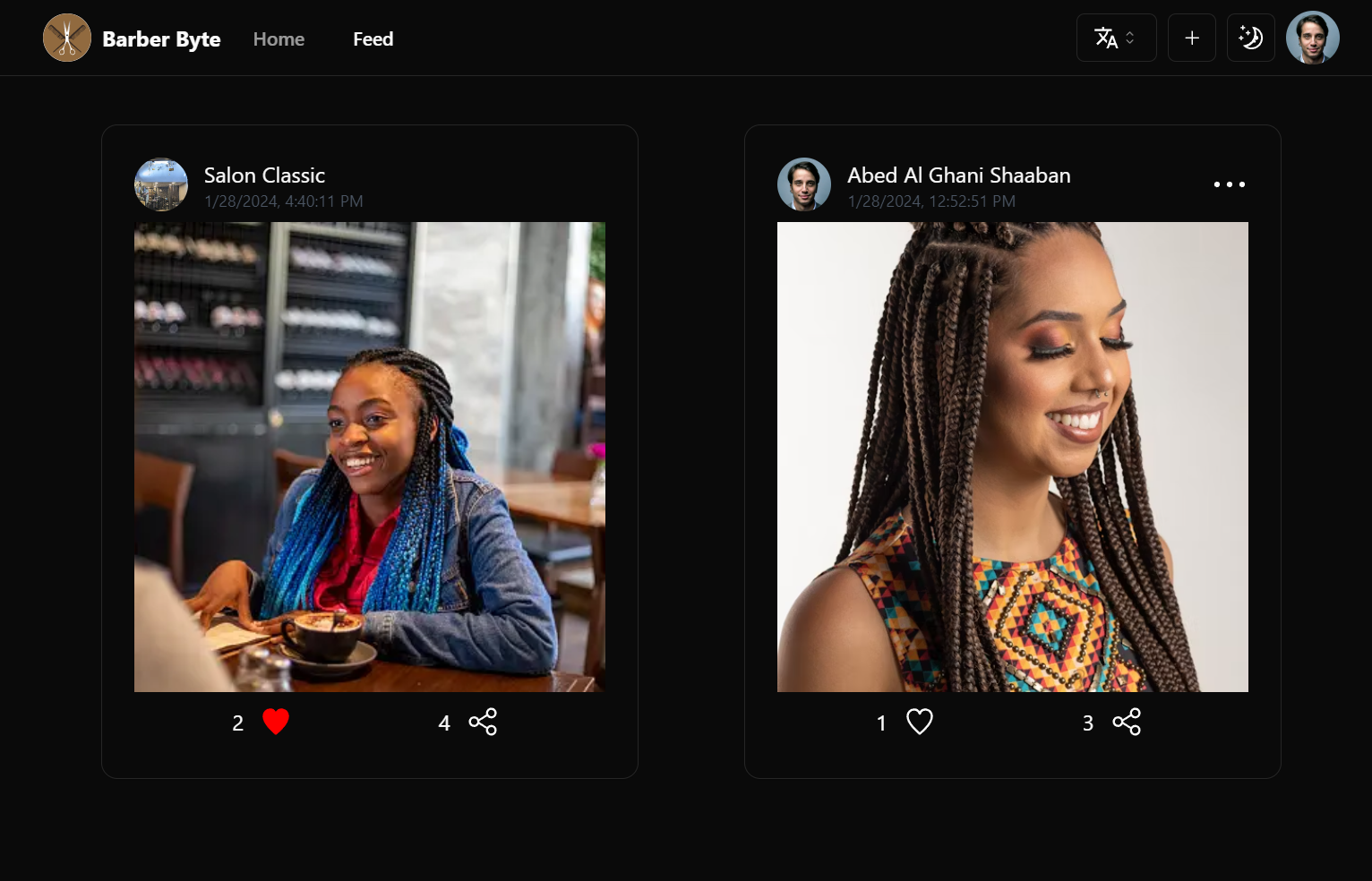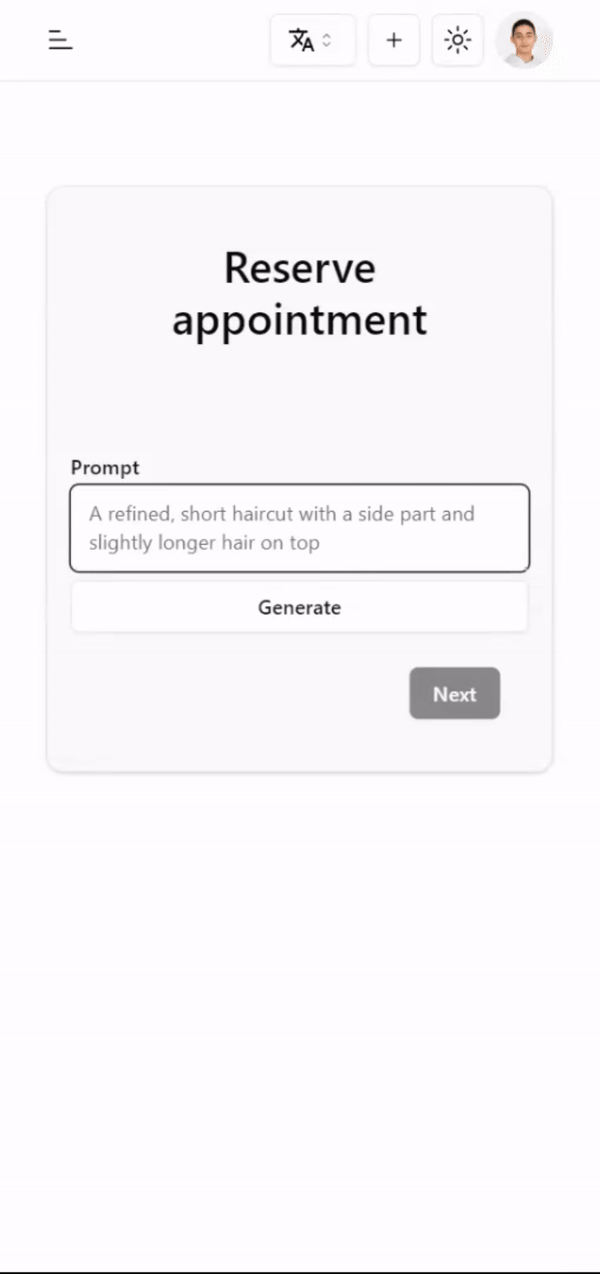A website for men and women to discover the best barber shops and reserve an appointment easily for their haircut.
Barber Byte also enables barbershop owners to manage their business on the desktop application. It helps them view their shop's data and clients' activity to help them predict their next move.
- As a client, I want to easily find nearby and high-quality barber shops and book appointments online to avoid long waits among a crowd of clients.
- As a client, I'm seeking the latest trends for hairstyling and haircut suggestions.
- As an admin, I need to monitor the project's performance closely to ensure its success and track user activity for effective management, allowing me to address user needs and enhance overall performance.
- As an admin, I want to analyze data to make informed decisions and optimize project outcomes.
- This project uses Turbo Repo. Turborepo is a high-performance build system for JavaScript and TypeScript codebases.
- For the frontend, the web app uses the Next.JS app router. Next.js is a React framework that supports server-side rendering.
- For the backend, Laravel is used. Leveraging the MVC model, Laravel ensures app security through well-structured routes, middleware, and authentication mechanisms.
- The foundation of this project is built upon Tauri, a framework for creating desktop applications. Building an optimized, secure, and frontend-independent application for multi-platform deployment.
- The app uses OpenAI API as an endpoint to request AI image-generated haircuts with DALL·E as recommended haircuts and showcases for clients.
Barber Byte's design journey involved crafting wireframes and mockups. Through iterative design processes, we refined the layout to achieve an optimal structure, ensuring easy navigation and a seamless user experience.
Check the project's wireframes and mockups on figma
The database is designed to facilitate the collection and management of user data within a comprehensive platform. Each table plays a crucial role in capturing various aspects of user interactions, preferences, and engagements.
| Home screen | Reservations screen |
|---|---|
| Reservation Image screen | Users Analytics Screen |
In this project, we support advanced prompt engineering techniques to enhance the interaction with natural language processing models. We carefully tell these models what to do by giving them specific instructions. The snippet below is an example of how we do it. By doing this, we ensure these models understand and create exactly what we want, making the whole process work smoothly and accurately for different tasks and preferences.
public function generate_image(Request $request){
$request->validate([
'prompt' => 'required|string',
'size' => 'required|string',
'n' => 'required|integer',
]);
// create the prompt
$prompt = "film still, portrait of a human, " . $request->prompt . ", salon photography";
try{
// generate the images with openai
$result = OpenAI::images()->create([
'model' => 'dall-e-2',
'prompt' => $prompt,
'size' => $request->size,
'style' => "vivid",
'n' => intval($request->n),
'user' => $this->user->uuid,
]);
// check if the images are generated
if(count($result->data) > 0){
// make a folder for the images if their is not one
$folder_path = 'images/ai-haircut/';
if (!file_exists(public_path($folder_path))) {
mkdir(public_path($folder_path), 0755, true);
}
$res = [];
// insert the images in the ai_images table
foreach ($result->data as $imageData) {
$image_url = time() . rand(3, 9000000000) . '.' . 'png';
file_put_contents(public_path($folder_path . $image_url), file_get_contents($imageData->url));
$image_id = AiImage::create([
'prompt' => $prompt,
'creator_id' => $this->user->uuid,
'img_url' => $image_url,
])->id;
// add images to the response
$res[] = [
'url' => $image_url,
'id' => $image_id,
];
}
return response()->json([
'status' => true,
'message' => 'Image generated successfully',
'data' => $res,
'error' => ''
], 200);
} else {
// handle error of zero images
return response()->json([
'status' => false,
'message' => 'Image not generated',
'data' => '',
'error' => 'zero images returned after generating'
], 500);
}
} catch (\Exception $exception){
// catch any error while generating images
return response()->json([
'status' => false,
'message' => 'Error occurred while generating image.',
'data' => '',
'error' => $exception->getMessage()
], 500);
}
}This piece of code is a small example of how we make sure the computer models create images exactly as we want them to, tailored to specific instructions and user needs.
This project leverages AWS deployment strategies to seamlessly integrate and deploy natural language processing models. With a focus on scalability, reliability, and performance, we ensure that AI applications powered by these models deliver robust and responsive solutions for diverse use cases.
By following these steps, we deployed the backend to Amazon Linux 2023.
- Update Amazon Linux 2023 Packages
- Install LAMP Stack
- Start and enable the Apache and MariaDB services
- Create Database
- Install PHP Composer for Laravel on Linux 2023
- Download the Laravel framework project
- Install Laravel on Amazon Linux 2023
- Create the Laravel environment configuration file
- Apache Configuration for PHP Laravel App
- Get the Laravel demo page
Commands are available in the backend folder
Barber Byte uses testing to make sure each piece of code works reliably and accurately. By checking individual units of the software systematically, we ensure a strong foundation. This helps us find and fix potential issues early in the development process.
These tests check different parts of the application, like user registration, shop creation, login, profile updates, post creation, and more. Each test makes sure a specific part of the system works correctly, making the overall software strong and dependable.
To set up Barber Byte locally, follow these steps:
This is an example of how to list things you need to use the software and how to install them.
- pnpm
npm install -g pnpm
-
Get an API Key at OpenAI
-
Clone the repo
git clone https://github.com/abedshaaban/barber-byte.git
-
Install PNPM packages
pnpm install
-
Setup the backend
- Change the directory to the backend folder
cd apps/backend - Install the required packages for Laravel
composer install
- Add Laravel environment variable for JWT via
Enter the required environment variables in
php artisan jwt:secret
/apps/backend.env - Migrate the database (make sure xamp is running)
php artisan migrate
- Run the server
php artisan serve
Now the server is running
- Change the directory to the backend folder
-
Setup the frontend
Enter the required environment variables in
.env(root folder)- Run the app
pnpm dev --filter=web
Now the web app is running
Now, you should be able to run Barber Byte locally and explore its features.















